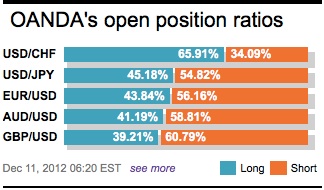The market seems content with the lack of market volatility, a carry over from yesterday’s session. With the Capital Markets data calendar light again today, many investors are waiting for wisdom from German data and development of the Greek buy-back program. After failing to meet it’s target, the Greek government extended the deadline for its buy-back program from Friday to today. The government hopes to retire close to +EUR20b in debt through the exercise pick-up, a prerequisite to receiving its next tranche of financial aid. So far, this has not stopped periphery yields from backing up.
To be fair, the Italian Prime Minister Monti’s decision to resign early has created political uncertainty for the region, especially Italy. By day’s end it will not just be a headache for Italy, but most likely Spain too. The Fixed income markets can be very persuasive and rising debt costs could force the Spanish Prime Minister to go cap-in-hand to Europe. This scenario is guaranteed to create greater volatility for the markets.

The ‘single unit’ was on the move after a sound German economic reading. It was only last week that the Bundesbank went out of its way to cut German growth rates for next year. This mornings German ZEW economic sentiment reading was firmly in the positive camp (6.9 vs. -15.7), the strongest print in seven-months. Experts suggest that the data is beginning to bottom out, rather than experiencing an economic upswing over the next six-months. The Christmas Grinch is still active! Analysts have been commenting that the bottoming-out theme would seem to be consistent with the Bundesbank’s view of +0.4% growth for next year. This does not impede the German economy from having a negative quarter here and there along the way.
For some, overnight Chinese data did not ooze enough economic confidence. Bank loans are one of the primary indicators for the growth landscape and data releases for last month were softer than expected. New lending by banks totaled +¥522.9b in November, up from +¥505.2b the previous month, but lower than what the market was expecting (+¥550b). A more consistent metric to follow is the broader “total social financing” print. It expanded only +¥1.14t, down from +¥1.29b in October and the smallest increase since August, but still greater y/y (2011; +¥958.1b). Digesting all this information still suggests that Chinese broad credit growth remains a very healthy +20.2%, y/y in November. This very much indicates that the Chinese economy remains within the economic recovery parameters.
Investors continue to keep a weary eye on any US development as the FOMC begins its two-day meet later today. Many are hoping that US policy makers might give an indication on the direction they plan to take over the coming months. Even with some recent US economic improvements, excluding the “Cliff,” overseers expect the Fed to bring forth some more policy easing. There is expected consensus that the FOMC will announce complementing its already +$40b/month MBS purchases with +$45b/month of Treasury purchases. Despite keeping the Fed’s +$85b/month purchase objective, the difference now is that the Treasury purchases would be unsterilized. Not meeting consensus should put pressure on the purchase of risky assets and any currencies geared towards global growth, such as the loonie.
For many, it’s all about the US budget deficit and the upcoming “fiscal cliff’ financial doomsday date. How much ‘real’ progress is being achieved between US political parties? Despite the Republicans and Democrats being responsible and on speaking terms, both sides still have sizable differences to overcome before any agreement can be reached by year-end. Most investors expect US politicians to come to an agreement on ways to avoid the ‘cliff,’ a package of +$600b tax and spending cuts. Lack of a deal continues to make investment decisions difficult. The clock remains ticking!

It’s beginning to look like the EUR’s low last Friday was the base. Technical analysts are beginning to wonder if its safe to announce that the daily single currency charts are oversold. For now, many should expect the most prudent strategy to take into consideration yesterday’s positive close. If so, investors would probably lean towards buying EUR outright on dips, despite the market’s bias being skewed towards the downside.

Other Links:
EURO to Mourn Monti’s Move
This article is for general information purposes only. It is not investment advice or a solution to buy or sell securities. Opinions are the authors; not necessarily that of OANDA Corporation or any of its affiliates, subsidiaries, officers or directors. Leveraged trading is high risk and not suitable for all. You could lose all of your deposited funds.



